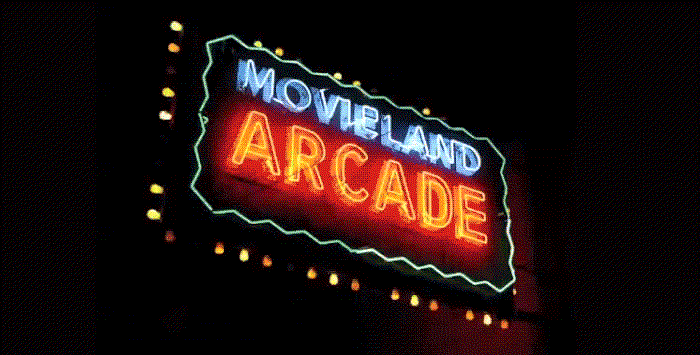We took a 1990’s guide to Vancouver sightseeing so we could get a sense of how much the city has changed. Follow this disjointed adventure as it unfolds, or learn more about the series HERE.
Granville Street
It can’t be much fun living with the feeling that you’re obsolete, that what you have to say about the world around you has no meaning in the present. After my guide’s inability to surface a single bookstore along Robson Street, making it seem like it could be the only book left in the world, its moral has to be low. If anybody needs a pick-me-up, it’s this Lonely Planet. What better place to find it than on Granville Street.
“Many of the music clubs are found along Granville St. while many of the dance clubs are found along Richards Street.” Although its words sound deflated and disinterested, I know my guide has to be hiding a more intriguing rendition of Granville Street than the Saturday afternoon version we’re standing on today. Instead of heading to the closest incinerator to enact on its planned euthanasia earlier than I had expected, I intend on finding it, and pledge to continue its suffering a little longer for the entertainment of us all. Besides, it deserves another chance to get back in the game. I wouldn’t expect anyone, professional guide or otherwise, to be enthused about suggesting a visit to the Granville Entertainment District, but this is different: this is the 90s!
Price of a first run movie ticket:1999: $8.75
2015: $12.99
My impression of Granville Street back then was a place that had a little something for everyone. The newly renovated Vogue Theatre brought internationally recognized acts to music fans looking for an alternative to arena-type shows; the Sugar Refinery featured more eclectic programming for the many Emily Carr Institute-types that frequented it; and a concentration of multiplex and repertory cinema screens offered endless hours of entertainment for the younger set. All this, plus it was flanked by the Starfish Room and Richards on Richards to the east, the city’s best blues bar, The Yale to the south, and let’s not forget Bosmans’s Motor Hotel, and its Side Bar Lounge just one block west. And of course, for the pervert that resides in us all, a healthy display of adult themed theatres and stores, which made it seem all the more exciting.
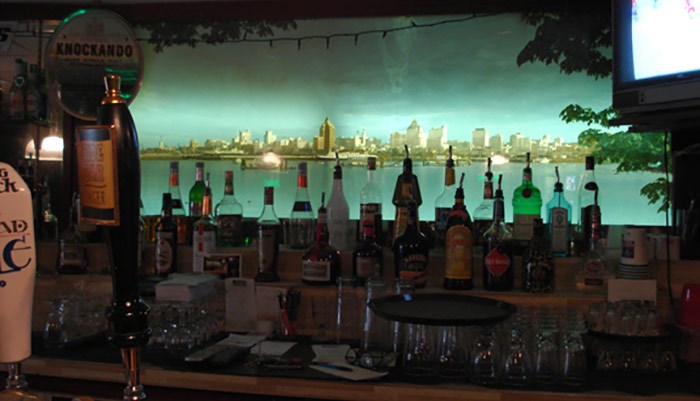 The Side Bar , one block west of Granville, with its backlit portrait of Vancouver in the 50s was a favourite after event hangout.
The Side Bar , one block west of Granville, with its backlit portrait of Vancouver in the 50s was a favourite after event hangout.
My guide sees it another way. The map it uses to suggest a tour of downtown cuts a wide swath of avoidance around this seven block artery of light that seems perfectly positioned to feed life, and tourist dollars, into the downtown core. Reference to Granville Street is spread throughout disparate sections of the guide that cover the obvious clubs and bars Granville was known for then, and mostly abhorred for now. Unlike other less worthy areas of the city, there is no section dedicated to Granville Street; no introductory paragraph to set the table with a little history about its designation as “theatre row;” no recognition of its impressive collection of neon signs; and although it mentions “plenty of greasy-spoon cafes and restaurants,” it suggests I visit very few of them — The Templeton is the only one that still exists today. Some place called The Goulash House, stands alone as the only dining room in the mid-range budget category it deems worth a visit, and having long since closed its doors, I only mention it because of the way my guide describes it as being “in an unfortunate part of the city, but worth the walk past the adult video stores and seedy hotels just for the delicious food.” There is merely a brief mention of one of Granville Street’s longest running clubs, a place that like the guide, has endured despite being completely irrelevant to current taste or style. “The Roxy has local and sometimes big name rock bands.” Great. Thanks.
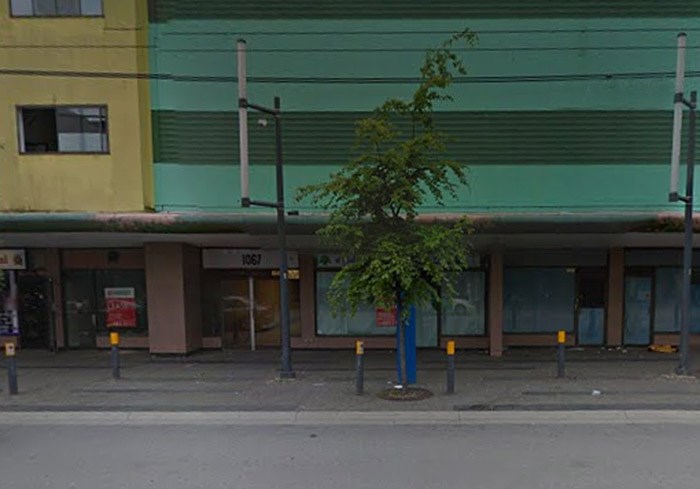 The guide’s only recommended mid-range dining destination, The Goulash House, sits vacant on Granville Street.
The guide’s only recommended mid-range dining destination, The Goulash House, sits vacant on Granville Street.
Had it not been sitting on a shelf for over a decade, my guide would have likely known that as the 2010 Olympics approached, Granville Street underwent a gentrification program to clean up its image of a place dominated by movie theatres, pinball arcades, and sex shops. But as most of us can appreciate, that didn’t make it a more pleasurable place to visit. The more liberal approach to liquor laws — don’t laugh, you couldn’t even walk around a bar holding a beer until the 70s — that ushered in Expo 86, combined with a raise in rent to drive out the sleeze, resulted in an entirely booze-based entertainment zone that only big clubs or condos can afford. It’s all pretty one dimensional, and the relatively recent strategy to contain the madness has only given it a three ring circus vibe that can only be appreciated by people that don’t have to deal with it weekend after weekend.
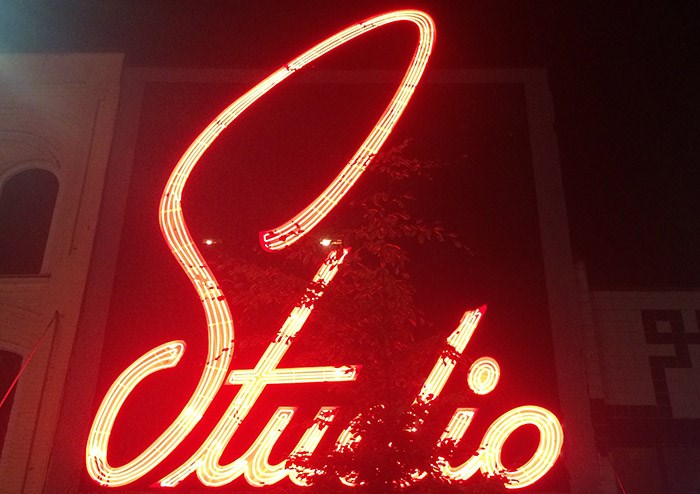 The Studio sign’s swanky “S” has made a prominent return to Granville Street after a 43 year hiatus.
The Studio sign’s swanky “S” has made a prominent return to Granville Street after a 43 year hiatus.
Still, a return to the variety that the Granville Street of the 90s seemed to offer might be on the horizon. The Commodore Ballroom’s revitalization in 1999 continued the Vogue’s nod to the area’s past for a new millennium, and while the Yale’s interior was entirely scraped clean of its history by a condo development, the street facing facade still exists, and is set to open as a BBQ serving saloon. Just this summer, Studio Records introduced Granville’s first all-in-one bar, record store, and performance space into what was a pretty predictable mix of establishments, and brought back an infamous neon sign that adorned the street from 1949 to 1972. None of these recent improvements has any bearing on my guide’s view of Granville, though. The bars it suggests we visit are either gone or closed, and there’s a long wait for a table at the Templeton. Anyone from any decade knows that only fools stand in line for brunch.
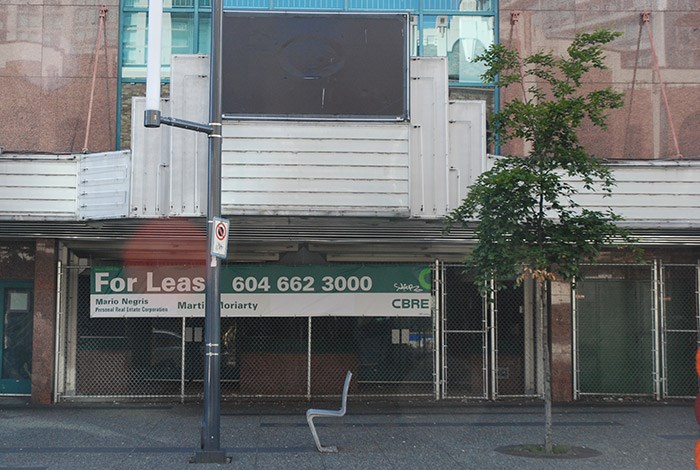 The Granville 7, the street’s last all-ages multiplex awaits a likely demolition.
The Granville 7, the street’s last all-ages multiplex awaits a likely demolition.
“There is a great selection of cinemas throughout the city,” my guide says, making another suggestion with the usual lack of enthusiasm that’s plagued this leg of our tour — notice how it also refuses to mention Granville Street? So I finally push back, and decide that although it can’t suggest a single cinema on Granville Street that hasn’t been torn down, turned into a condo, or wrapped in a chain link fence to await development, there’s still one left. A place that, despite rumours that it’s been of another era since the day it opened, has reached a legendary status for its ability to survive; just like The Roxy; just like my guide. Without protest from its pages, we walk through the doors of Movieland Arcade and into a double barrelled river of pinball machines that flood the senses with flashing lights and raging sounds. We proceed straight to the back of the room with a stack of quarters, to the “Theatre for Men,” where Granville Street’s last remaining multiplex resides in several, separately licensed, personal movie screens. Each show classic, short, looping erotica on real 35mm film — a cultural dinosaur kept alive for mysterious, unprofitable ends. While the rest of the world progresses around it, Movieland Arcade has stayed the same, helping it to reach a level of respect few other establishments along Granville enjoy today.
While we didn’t find a bookstore to make my Lonely Planet feel a little less lonely, we found a like-minded survivor in an unexpected place, the “seedy” underbelly of Granville Street. And with it, the realization that being a little out of sync with everything around you can be appreciated, as long as you hang on to the past long enough.
Worried about the funk our Lonely Planet guide is in? Fear not! This story is finally getting to an hour when it’s acceptable to start drinking. It all takes place in Yaletown, and in next week’s Guided by the 90s. Learn about this series.
